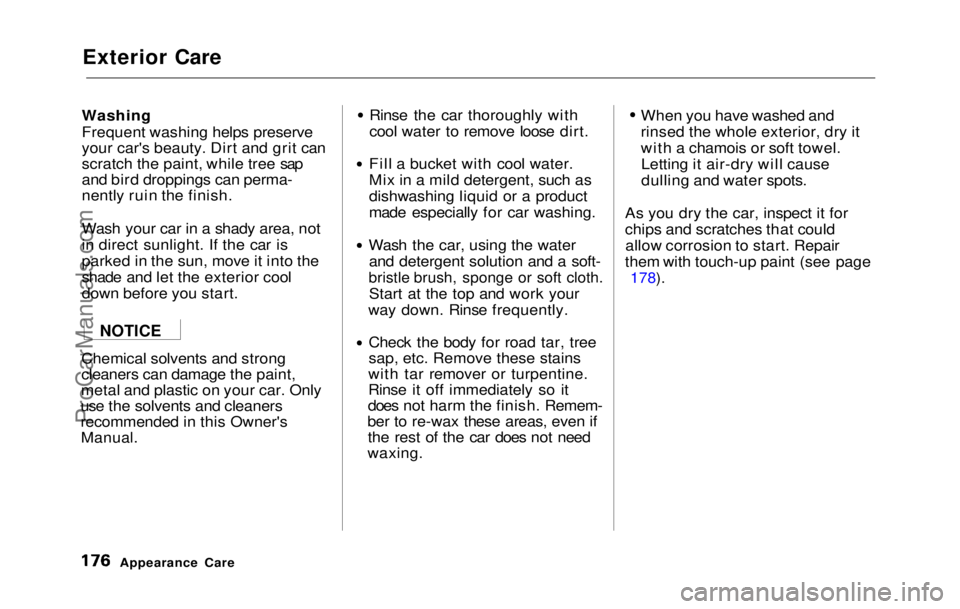Page 167 of 225
Lights
Replacing Rear Bulbs
1. Open the trunk and the taillight
assembly cover.
2. Use
a phillips head screwdriver
to remove the two screws from
the bulb holder. Remove the
holder from the taillight assem-
bly.
3. Try the tail/stoplights, rear turn
signals and back-up lights to
verify which bulb needs replac- ing. Remove that bulb from the
socket by pushing it in slightly
and turning it counterclockwise.
4. Instal l
the new bulb in the socket.
Test it to make sure it works.
5. Reinstal
l
the bulb holder assem-
bly. Install the two screws and
tighten them securely.
Maintenance
COVERProCarManuals.comMain Menu Table of Contents s t
Page 168 of 225
Lights
Replacing a Rear Side Marker
Light Bulb
1. Use a phillips-head screwdriver
to loosen the side marker assem-
bly mounting screw.
2. Remove
the assembly from the
fender by pulling out the back
edge and sliding the assembly
backwards.
3. Remove the socket from the
light assembly by turning it
counterclockwise.
4. Remov
e
the bulb from the socket
by pulling it straight out.
Install the new bulb. Turn on the
headlights to test the bulb.
5. Inser t
the socket in the assembly.
Turn it clockwise to lock it in
place.
6. Reinstal
l
the side marker assem-
bly in the fender. Tighten the
mounting screw securely.
Maintenance
SCREWProCarManuals.comMain Menu Table of Contents s t
Page 169 of 225
Lights
Replacing a Rear License
Bulb
1. Remove the two screws and remove the license light assem-
bly.
2. Remove the lens from the rubber
seal and the metal
cover.
3. Pull the bulb straight out of its
socket. Push the new bulb in
until it bottoms in
the socket.4. Turn on the parking lights and
check that the new bulb is
working.
5. Reinstall the cover and the lens.
Put the license light assembly in
place. Reinstall the two screws
and tighten them securely.
Replacing
Interior and Trunk
Light Bulbs
1. Remove the lens by carefully
prying on the edge of the lens in
the middle with a fingernail file
or a small flat-tip screwdriver.
Do not pry on the edge of the
housing around the lens.
CONTINUED
Maintenance
INTERIOR
LIGH
TProCarManuals.comMain Menu Table of Contents s t
Page 170 of 225
Lights
2. Remove the bulb by pulling it straight out of its metal tabs.
3. Push the new bulb into the metal tabs. Snap the lens back in place.
Maintenance
TRUNK LIGHTProCarManuals.comMain Menu Table of Contents s t
Page 171 of 225

Storing Your Car
If you need to park your car for an
extended period (more than 1
month), there are several things
you should do to prepare it for
storage. Proper preparation helps
prevent deterioration and makes it
easier to get your car back on the
road. It is best to store your car indoors if at all possible. Fill the gas tank.
Change the engine oil and filter
(see page 137).
Wash and dry the exterior
completely.
Clean the interior. Make sure the
carpeting, floor mats, etc. are
completely dry.
Leave the parking brake off. Put
the transmission in Reverse (5-
speed) or Park (automatic). Block the rear wheels.
If the car is to be stored for a
longer period, it should be
supported on jackstands so the
tires are off the ground.
Leave one window open slightly
(if the car is being stored indoors).
Disconnect the battery.
Cover the car with a "breathable" car cover, one made
from a porous material such as
cotton. Nonporous materials,
such as plastic sheeting, trap
moisture which can damage the
paint. If possible, run the engine for a
while periodically (preferably once a month). If you store your car for 12 months
or longer, have your Honda dealer
perform the inspections called for
in the 24 months/48,000 km (30,000
miles) maintenance schedule as
soon as you take it out of storage
(see page 133). The replacements
called for in the maintenance
schedule are not needed unless the
car has actually reached that time or mileage.
MaintenanceProCarManuals.comMain Menu Table of Contents s t
Page 173 of 225

Exterior Care
Washing
Frequent washing helps preserve
your car's beauty. Dirt and grit can
scratch the paint, while tree sap
and bird droppings can perma-
nently ruin the finish.
Wash your car in a shady area, not
in direct sunlight. If the car is
parked in the sun, move it into the
shade and let the exterior cool
down before you start.
Chemical solvents and strong
cleaners can damage the paint,
metal and plastic on your car. Only
use the solvents and cleaners
recommended in this Owner's
Manual.
Rinse the car thoroughly with
cool water to remove loose dirt.
Fill a bucket with cool water.
Mix in a mild detergent, such as
dishwashing liquid or a product
made especially for car washing.
Wash the car, using the water and detergent solution and a soft-bristle brush, sponge or soft cloth.
Start at
the top and work your
way down. Rinse frequently.
Check the body for road tar, tree
sap, etc. Remove these stains
with tar remover or turpentine.
Rinse it off immediately so it
does not harm the finish. Remem-
ber to re-wax these areas, even if the rest of the car does not need
waxing. When you have washed and
rinsed the whole exterior, dry it
with a chamois or soft towel.
Letting it air-dry will cause
dulling and water spots.
As you dry the car, inspect it for
chips and scratches that could allow corrosion to start. Repair
them with touch-up paint (see page
178).
Appearance Care
NOTICEProCarManuals.comMain Menu Table of Contents s t
Page 174 of 225

Exterior Care
Waxing
Always wash and dry the whole car
before waxing it. You should wax your car, including the metal trim,
whenever water sits on the surface in large patches. It should form into
beads or droplets after waxing.
You should use a quality liquid orpaste wax. Apply it according to
the instructions on the container. In
general, there are two types of products:
Waxes — A wax coats the finish and protects it from damage by
exposure to sunlight, air pollution,
etc. You should use a wax on yourHonda when it is new.
Polishes — Polishes and cleaner/
waxes can restore the shine to
paint that has oxidized and lost
some of its shine. They normally
contain mild abrasives and solvents
that remove the top
layer of the
finish. You should use a polish on
your Honda if the finish does not
have its original shine after using a
wax.
Cleaning tar, insects, etc.
with
removers also takes off the wax.
Remember to re-wax those areas,
even if the rest of the car does not
need waxing.
Aluminum
Wheel
s
Clean your Honda's aluminum alloy
wheels as you do the rest of the exterior. Wash them with the same
solution, and rinse them thoroughly.
The wheels have a protective clear-
coat that keeps the aluminum from
corroding and tarnishing. Using
harsh chemicals, including some
commercial wheel cleaners, or stiff
brushes can damage this clear-coat.
Only use a mild detergent and soft
brush or sponge to clean the wheels.
Appearance CareProCarManuals.comMain Menu Table of Contents s t
Page 179 of 225

Taking Care of the Unexpected
This section covers the more- common problems that motorists
experience with their cars. It gives
you information about how to
safely evaluate the problem and
what to do to correct it. If the problem has stranded you on the
side of the road, you may be able to
get going again. If not, you will also
find instructions on getting your
car towed. Compact Spare Tire..................... 184
Changing a Flat Tire................... 185
If Your Engine Won't Start........ 190 Nothing Happens...................... 190
The Starter OperatesNormally................................ 191
Jump Starting................................ 191 If Your Engine Overheats.......... 193
Low Oil Pressure.......................... 195
Charging System Indication ...... 196
Check Engine Light..................... 197
Closing the Sunroof ..................... 198
Fuses............................................... 199 Checking and Replacing.........
200
Towing...........................................
202
Taking Car e
of the UnexpectedProCarManuals.comMain Menu s t